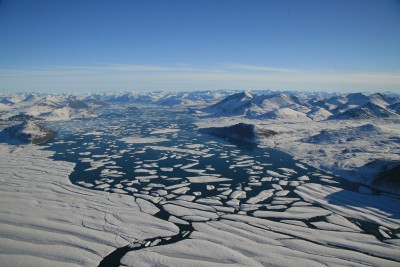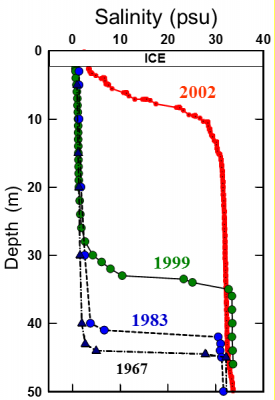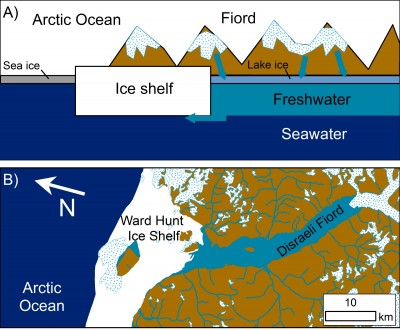Disraeli Fiord epishelf lake drainage
Oceanographic surveys along the northern coast of Ellesmere in the 1950’s revealed the existence of a highly stratified water column in Disraeli Fiord behind the Ward Hunt Ice Shelf (WHIS). The freshwater layer was almost 63 m deep and directly overlay seawater, the layers separated by a very sharp salinity gradient, or halocline, only a few meters thick. The Disraeli Fiord epishelf lake was the largest epishelf lake in the Northern Hemisphere, extending over an area roughly 223 km2, containing ~6.1 km3 of freshwater.

The Ward Hunt Ice Shelf breaking up into Disraeli Fiord. The fiord was historically perennial ice covered, but after the drainage of the epishelf lake has transitioned to seasonal ice cover. Note the serpentine fracture in the foreground which marks the fracture through which the epishelf lake drained. (D. Sarrazin)
The epishelf lake was fed by meltwater runoff from the surrounding glacial catchment, and its depth appear to be controlled by the draft of the Ward Hunt Ice Shelf. The depth of the freshwater layer roughly corresponded to the measured thickness of the WHIS, indicating that excess freshwater must flow out under the ice shelf to the ocean. Researchers suggested that monitoring the depth of the freshwater layer could be a useful way to record changes in the thickness of the ice shelf.
Water column profiles collected in Disraeli Fiord between 1967 and 1999 revealed the epishelf lake thinned from roughly 43 m to 28 m over this period. This thinning corresponded to a period of regional atmospheric warming and seemed to indicate that the ice shelf was losing mass in the warming climate.
Between 1999 and 2002 a major crack formed in the WHIS that extended completely across the ice shelf from north to south. The consequence was the catastrophic drainage of the Disraeli Fiord epishelf lake. The loss of the Disraeli Fiord epishelf lake, which had existed for much of the past 4500 years, resulted in the loss of a rare and fascinating ecosystem, where freshwater and marine biota occupied the same water column.
Since the fracture of the WHIS and the loss of the Disraeli Fiord epishelf lake, the widespread breakup of ice shelves along the northern coast of Ellesmere Island has resulted in the thinning and loss of the majority of the epishelf lakes along this coast. In 2011, members of the WIRL began an intensive study of the Milne Fiord e

The loss of the freshwater epishelf lake in Disraeli Fiord. Over the years, researchers lowered instruments into the water column to measure salinity. The salinity was near zero indicating freshwater lay in the upper water column before transitioning rapidly to sea water. In 2002, the profiles shows a dramatic loss of most of the epishelf lake which flowed through a crack in the Ward Hunt Ice Shelf and was replaced by sea water from below.
pishelf lake, the last known large epishelf lake in the Canadian Arctic.
Resources:
Antoniades, D., Francus, P., Pienitz, R., St-Onge, G., and Vincent, W. F.: Holocene dynamics of the Arctic’s largest ice shelf, Pro- ceedings of the National Academy of Sciences of the United States of America, 108, 18 899–18 904, doi:10.1073/pnas.1106378108, wOS:000297249800016, 2011.
Mueller, D. R., Vincent, W. F., and Jeffries, M. O.: Break-up of the largest Arctic ice shelf and associated loss of an epishelf lake, Geophysical Research Letters, 30, 1–4, doi:10.1029/2003GL017931, 2003.
Veillette, J., Mueller, D. R., Antoniades, D., and Vincent, W. F.: Arctic epishelf lakes as sentinel ecosystems: Past, present and future, Journal of Geophysical Research, 113, 1–11, doi:10.1029/2008JG000730, 2008.

A schematic of an epishelf lake showing the freshwater layer that is impounded behind the ice shelf. Since the freshwater is less dense than the Arctic Ocean it persists in this layer and forms a lake. A map of Disraeli Fiord is below.
This research was conducted at Université Laval under the supervision of Warwick Vincent and made possible by in-kind and financial support from Polar Shelf, NSERC, NSTP, the Alaska Satellite Facility and the Canada Foundation for Innovation.
